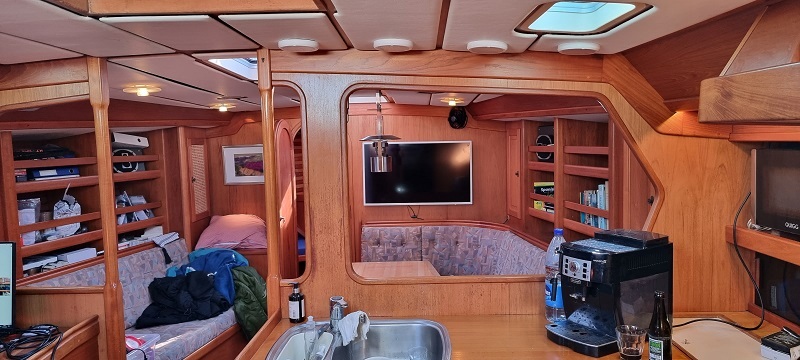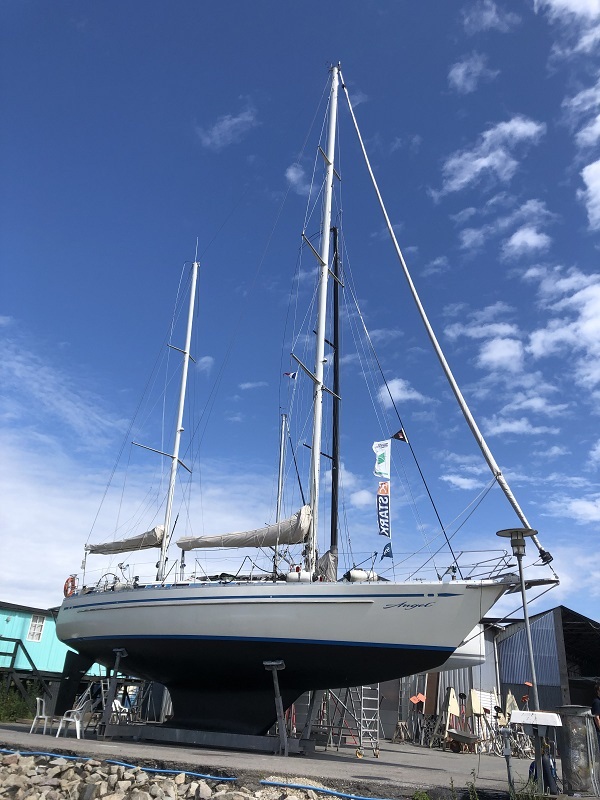Review of Columbie 451

Basic specs.

Looking for a new boat? Find a Columbie 451 or similar boat for sale
Both the hull and the deck is made of hand laid fibreglass. Generally, a hull made of hand laid fibreglass requires only a minimum of maintenance during the sailing season.
Both the hull and the deck is a sandwich construction which improves the indoor climate. Especially when the water is colder than the air in the cabin, then the double hull insulates against cold water and reduce the condense water in the cabin. The core material in the sandwich construction is balsa.

The boat is equipped with 4-11 berths, a galley, 550.0 liter fresh water capacity and toilet facility.
Note: the boat has also been sold to be self-made/-interiored, which means that the quality of each boat may vary.
The Columbie 451 is equipped with a ketch rig. A ketch rig is generally considered easier to handle, because the sails are smaller, and because it can sail on most points to the wind with one sail completely taken down for repair or while reefing. The sail configuration of a ketch allows for better comfort and stability when sailing downwind or on a broad reach.

Fin keel
The Columbie 451 is equipped with a fin keel. A boat with a fin keel is more manoeuvrable but has less directional stability than a similar boat with a full keel.
The keel is made of lead. Compared with iron, lead has the advantage of being 44% heavier, which allows a smaller keel and hence less water resistance and higher speed.
Columbie 451 can only enter major marinas as the draft is about 2.00 - 2.10 meter (6.56 - 6.86 ft) dependent on the load. See immersion rate below.
The Columbie 451 has been equipped with different engine alternatives.
Alternative 1:
The boat may be equipped with an inboard Mercedes-Benz OM 314 diesel engine at 80 hp (59 kW). Calculated max speed is about 7.2 knots
The transmission is a shaft drive. A shaft drive will in the long run require less maintenance than other types of drive e.g. a sail drive.
Alternative 2:
The boat may be equipped with an inboard Ford engine at 70 hp (52 kW). The speed is 9.0 knots.
The fuel tank, which is made of stainless steel, has a capacity of 400.0 liters (105 US gallons, 87 imperial gallons).
Sailing characteristics
This section covers widely used rules of thumb to describe the sailing characteristics. Please note that even though the calculations are correct, the interpretation of the results might not be valid for extreme boats.
What is Capsize Screening Formula (CSF)?
The capsize screening value for Columbie 451 is 1.82, indicating that this boat could - if evaluated by this formula alone - be accepted to participate in ocean races.
What is Theoretical Maximum Hull Speed?
The theoretical maximal speed of a displacement boat of this length is 8.2 knots. The term "Theoretical Maximum Hull Speed" is widely used even though a boat can sail faster. The term shall be interpreted as above the theoretical speed a great additional power is necessary for a small gain in speed.
The immersion rate is defined as the weight required to sink the boat a certain level.
The immersion rate for Columbie 451 is about 336 kg/cm, alternatively 1886 lbs/inch.
Meaning: if you load 336 kg cargo on the boat then it will sink 1 cm.
Alternatively, if you load 1886 lbs cargo on the boat it will sink 1 inch.
Sailing statistics
This section is statistical comparison with similar boats of the same category. The basis of the following statistical computations is our unique database with more than 26,000 different boat types and 350,000 data points.
What is Motion Comfort Ratio (MCR)?
The Motion Comfort Ratio for Columbie 451 is 35.1.
What is L/B (Length Beam Ratio)?
The l/b ratio for Columbie 451 is 3.13.
The ballast ratio for Columbie 451 is 413%.
What is Displacement Length Ratio?
The DL-ratio for Columbie 451 is 272 which categorizes this boat among 'light crusers & offshore racers'.
Maintenance
As balsa wood is used as sandwich core material special care must be taken in relation to work that require penetration of the sandwich construction in order to to prevent water to get in contact with the balsa wood. Otherwise the balsa wood will eventually rotten and be expensive/impossible to repair.
When buying anti-fouling bottom paint, it's nice to know how much to buy.
The surface of the wet bottom is about 55m2 (592 ft2).
Based on this, your favourite maritime shop can tell you the quantity you need.
Note: If you use a paint roller you will need more paint than if you use a paintbrush.
If you need to renew parts of your running rig and is not quite sure of the dimensions, you may find the estimates computed below useful.
| Usage | Length | Diameter | ||
| Jib sheet | 13.8 m | (45.3 feet) | 16 mm | (5/8 inch) |
| Genoa sheet | 13.8 m | (45.3 feet) | 16 mm | (5/8 inch) |
| Mainsheet | 34.5 m | (113.2 feet) | 16 mm | (5/8 inch) |
| Spinnaker sheet | 30.4 m | (99.6 feet) | 16 mm | (5/8 inch) |
This section is reserved boat owner's modifications, improvements, etc. Here you might find (or contribute with) inspiration for your boat.
Do you have changes/improvements you would like to share? Upload a photo and describe what you have done.
We are always looking for new photos. If you can contribute with photos for Columbie 451 it would be a great help.
If you have any comments to the review, improvement suggestions, or the like, feel free to contact us. Criticism helps us to improve.
